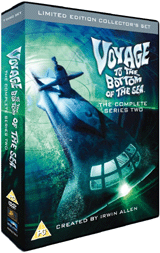 Irwin Allen, the cult producer of various fanciful sixties TV sci-fi shows including Lost In Space, The Time Tunnel and Land Of The Giants, was best known as a purveyor of factually incorrect, faintly ridiculous camp classics.
Irwin Allen, the cult producer of various fanciful sixties TV sci-fi shows including Lost In Space, The Time Tunnel and Land Of The Giants, was best known as a purveyor of factually incorrect, faintly ridiculous camp classics.
Voyage To The Bottom Of The Sea, perhaps his most successful series, clocking in at a healthy four seasons, represented a somewhat more realist approach. Or, that is, as grimly realistic as an Irwin Allen production could be.
The TV run of Voyage, following the big screen adventure flick of the same name, told the story of the crew of the high-tech naval submarine, the SSRN Seaview, as they were thrown into all kinds of outlandish situations.
Set in the near future (this time round, the seventies, as opposed to Land Of The Giants‘ equally ridiculous eighties setting), the first season focused largely on the vessel’s encounters with hostile foreign nations and regular attempts to avert disaster. Filmed entirely in black and white, its stoic heroes – Admiral Harriman Nelson, played by the moderately successful film star Richard Baseheart, and Commander Lee Crane (David Hedison) – led the audience through the standard shaky sets and cameras being unconvincingly shaken with granite-faced aplomb. Filled with Cold War paranoia and overriding seriousness, Voyage always felt like the grumpy older brother of the Allen family.
This second season, filmed in Technicolor, represents a departure. The tough guy sub crew are all present and correct (except for Chief “Curly” Jones, played by actor Henry Kulky, who passed away between seasons) and there’s still a good deal of patronising anti-Commie lecturing to contend with, but with the bright new colours comes Allen’s flamboyant penchant for sea monsters, aliens and malignant machines.
Fans of Allen’s more light-hearted fare will immediately recognise the flimsy sets, apparent in opening episode, ‘Jonah And The Whale’, where our heroes, unsurprisingly, end up wallowing around on pastel-coloured inflatables, representing a whale’s stomach. From here on, Voyage embraces the ridiculousness Allen’s famous for.
Still, where Voyage fails is in taking itself far too seriously. Where Lost In Space had its Dr Smith mincing about outrageously and Land Of The Giants had its cowardly lion Fitzhugh, Voyage only has deadly serious cardboard characters and pretentious pro-USA propaganda. Conflict emerging between shipmates should be an interesting, dramatic twist, but this only works if you care for said characters. It’s quite an achievement to write sullen-faced plots that somehow make ingredients such as a lost dinosaur island and alien invaders almost boring.
Admittedly, when the action is in full flow, Voyage can be enjoyable and there’s endless fun to be had purely appreciating the set design and clumsy special effects. However, there’s very little to keep the viewers’ attention for the rest of the show and Voyage To The Bottom Of The Sea emerges as a relic that should have been left to sink.
![]()
Released on DVD on Monday 13th June 2011 by Revelation Films Ltd.
Watch the trailer…

